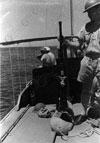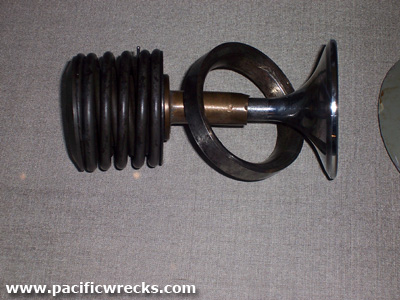|
|
|
|
| Missing In Action (MIA) | Prisoners Of War (POW) | Unexploded Ordnance (UXO) |
| Chronology | Locations | Aircraft | Ships | Submit Info | How You Can Help | Donate |
|
| IJN 4th Kōkūtai  IJN March 1, 1942  Daniel Leahy 2004  Daniel Leahy 2012 |
Pilot Sea1c Katsuro Nagatomo (survived, POW suicide August 5, 1944) Crashed February 28, 1942 Aircraft History Built by Nakajima. At the factory painted overall gray with a black cowl. Delivered to the Imperial Japanese Navy (IJN) as A6M2 Model 21 manufacture number 911 (unconfirmed). Wartime History On February 17, 1942 one of six Zero from Shoho that landed at Lakunai Airfield. These were the first Zero land based Rabaul. Assigned to the 4th Kokutai (4th Air Group). Tail Number F-??? (three digits). No known markings. Mission History On February 28, 1942 took off from Lakunai Airfield at Rabaul piloted by Sea1c Katsuro Nagatomo as one of six Zeros led by Harutoshi Okamoto on a mission to escort G4M1 Betty bombers over Port Moresby. Over the target, the Zeros encountered no resistance so they tested their guns on the Moresby Wreck (SS Pruth), then strafed flying boats moored in Fairfax Harbor off Napa Napa and sink Catalina A24-3 and Catalina A24-6. During the firing pass, this Zero was hit by gunfire from a single 7.7mm Lewis machine gun emplaced above Napa Napa. Damaged, Nagatomo flew eastward and was able to bail out before his Zero crashed into Bootless Bay. Prisoner Of War Nagatomo was aided ashore by soldiers from the Australian Army. He was badly burned on his legs and taken to the hospital for treatment. Nagatomo became the the first Prisoner Of War (POW) captured in the Australian Territory of New Guinea during World War II and was assigned prisoner number PWJA.100015. Soon afterwards, he was transported to Australia for medical treatment at the RAAF hospital at Laverton near Melbourne. While hospitalized for six months, he was interrogated for an hour session over seven days. During these interrogations, he used the alias "Katsuro Sho" or "Eiori" and was "not inclined to be helpful" and responded to some questions with "scornful contempt". While recovering, he became friends with the nurse caring for him who he described as "a mature and understanding woman" and a chaplain at the hospital. Due to these relationships, his attitude changed and he freely answered technical questions. Later, he was transfered to Redholme Manson in South Yarra, Victoria. During the springtime and was given unrestricted use of the grounds and answered questions from intelligence material section. He was asked to make a propaganda broadcast stating that Japanese prisoners were being fairly treated, which he declined, and requested to join other prisoners "to suffer with them". His request was initially declined and he remained at Redholme Manson, in hopes of further cooperation. At one time, Nagatomo even offered to become an a hospital orderly, in hopes of seeing the nurse or chaplain he befriended. Eventually, the Australians agreed to his request to join other Japanese prisoners. On May 22, 1943 interned at Cowra POW Camp as a Prisoner Of War (POWs) with other Japanese captured in Australia, New Guinea and the Solomon Islands. In captivity, Nagatoma and other Japanese Navy officers became the leaders of the camp, but as more Japanese Army prisoners were added to the camp population, their leadership was diminished. By early 1944, there were 1,100 Japanese prisoners at the camp, larger than the capacity of the camp or guards. The aviators including Nagatomo made alliances with the other extremist Navy and Army prisoners. As time passed, they decided on a ban on all labor and planned a riot and breakout with the goal of engaging the Australian guards in a suicidal battle to die honorably. During the planning, the prisoners gave the impression of being contented and cooperative. On August 4, 1944 at 5:00pm, fifty of the senior prisoners met in B Compound to complete planning for the riot and breakout and debate the merits of the plan. They decided to take a vote of all the prisoners and go with the choice of the majority of the prisoners who voted yes or no with a circle or cross on toilet paper. Survivors estimate 80% voted in favor, but might have been intimidated into voting yes. The prisoners celebrated and said their farewells into the night. On August 5, 1944 at 2:00am Hajime Toyoshima signaled the start of the breakout with a bugle and the prisoners from Compound B attempted to rush the perimeter fence near the Vickers machine gun, the northeast F guard tower and Broadway gate. While trying to escape, Nagatomo was hit by a bullet in his left left side and died. Wreckage After the crash, Australian Army 39th Battalion 'C' Company Captain Robinson located the crash site, and were able to bring some wreckage to the surface with help from natives from the Tubusereia area. On March 1, 1942 a "fishing expedition" including RAAF Lt. Collet, RAN Captain Benjamin plus four natives from Rabaul aboard auxiliary ship Leander found the crash site in Bootless Bay. Diving down, they recovered more wreckage including a single 20mm cannon serial number 1339 (or 1389) then returned to Port Moresby. Likely the recovered material was sent to Australia for technical evaluation. Their ultimate fate or location is unknown. Sometime later, RAAF intelligence found a drop tank deemed to be from this Zero. Today, SCUBA divers in Bootless Bay report the presence of a wreck in murky water. Photographic evidence or confirmation is yet to be produced by a diver. Display A small valve recovered from the wreck by the Australian Army is displayed in Aircraft Hall at the Australian War Memorial. Also, several smaller pieces of wreckage are also in their collection: piping from Zero (AWM REL/16104.001), electrical cable (AWM REL/16104.002), direction indicator plate (AWM REL/16104.003) and shattered stud mount (AWM REL/16104.004). Memorials Nagatomo is buried at Cowra Japanese War Cemetery at grave QC 29 / 21125. References War Diary HQ Inf Bde March 1, 1942 Intel Summary No. 15 and Appendix 1 Australian Post "Where Japs got the third degree" by David Sissons, July 17, 1986, page 4 War Diary 1942 (1984) page 30 "February 28, 1942: ...a Japanese fighter was shot down in flames on the reef near Bootless Inlet. The pilot baled out and was captured, the first Japanese prisoner taken on Australian Territory in the war. The pilot was badly burned and taken to hospital." Kijyo-nschi "Killed In Action, In Fact, A Life of a POW in Australia" July 10, 2004 Wrecks & Reefs (1994) pages 27 Thanks to Harumi Sakaguchi, Robert Piper, John Douglas and Daniel Leahy for additional information Contribute Information Are you a relative or associated with any person mentioned? Do you have photos or additional information to add? Last Updated May 11, 2025 |
Zero Photo Archive |
| Discussion Forum | Daily Updates | Reviews | Museums | Interviews & Oral Histories |
|